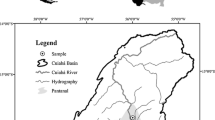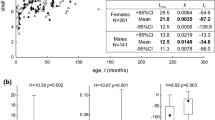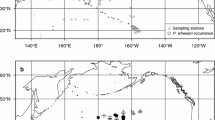Summary
The correlations between certain life-history parameters (reproductive effort, reproductive life-span, age of first reproduction, general growth index, variation in juvenile survival, availability of resources) were studied in 13 populations of the mussel Anodonta piscinalis in south-western Finland in 1975 and 1976
Reproductive life-span correlated positively (r s=0,823, P<0.001) with variation in juvenile survival. The average availability of resources correlated negatively both with the reproductive life-span (r s=-0.841, P<0.001 after the variation by juvenile survival had been deleted) and variation in juvenile survival (r s=-0.676, P<0.05).
The reproductive effort for female mussels at each site was computed by comparing body weight of reproductive females with body weights of non-reproductive individuals. Availability of resources was much higher in 1976 than in 1975. Consequently, the reproductive effort, an index of the strain of reproduction, was higher in 1975 than in 1976. In 1975 there was a significant correlation between reproductive effort and the length of the reproductive life-span (-0.727, -0.806) and also with the reproductive effort and the variation in juvenile survival (-0.718, -0.758) in females of the length of 60 mm and 70 mm respectively. In 1976, when availability of resources was better, such correlations were not found.
Spatial and temporal change in the intake of resources complicates applicability of the principle of resource allocation in the theory of life-history evolution. Studying the mere allocation is not enough if the intake of resources varies in the groups studied. The ratio ovary weight/body weight is a dubious measure of reproductive effort in comparative studies when the input of resources can vary, and this possibility can be ruled out only exceptionally.
Correlation between growth and reproductive effort was positive, obviously because both are important components in creating high reproductive capacity. In 1975 reproductive effort increased with size (age). Change in reproductive effort correlated with reproductive life-span (r s=-0.633, P<0.05).
The following parameters occurred together: short reproductive life-span, low age of first reproduction, high reproductive effort, rapid growth and high clutch size. They were realized at sites where the availability of resources was good and variation in juvenile survival was low-i.e. the environment was stable. The results conflict with the prediction of the theory of r and K-selection.
Similar content being viewed by others
References
Ballinger, R.E., Clark, D.R.: Energy content of lizard eggs and the measurement of reproductive effort. J. Herpetol. 7, 129–132 (1973)
Cole, L.C.: The population consequences of life history phenomena. Q. Rev. Biol. 29, 103–137 (1954)
Darwin, C.: On the origin of species by means of natural selection, or the preservation of favored races in the struggle for life. London: Murray 1859
Fisher, R.A.: The genetical theory of natural selection. Oxford: Clarendon Press 1930
Gadgil, M., Bossert, W.H.: Life historical consequences of natural selection. Am. Nat. 104, 1–24 (1970)
Harper, J.L., Ogden, J.: The reproductive strategy of higher plants. I. The concept of strategy with special reference to Senecio vulgaris L. J. Ecol. 58, 681–698 (1970)
Haukioja, E., Hakala, T.: Vertical distribution of freshwater mussels (Pelecypoda, Unionidae) in southwestern Finland. Ann. Zool. Fenn. 11, 127–130 (1970)
Haukioja, E., Hakala, T.: Measuring growth from shell rings in populations of the mussel Anodonta piscinalis. Ann. Zool. Fenn 15, 60–65 (1978a)
Haukioja, E., Hakala, T.: Asymptotic equations in growth studies—an analysis with Anodonta piscinalis (Nilsson). Ann. Zool. Fenn 15 (in press, 1978b)
Hirshfield, M.F., Tinkle, D.W.: Natural selection and the evolution of reproductive effort. Proc. Nat. Acad. Sci. 72, 2227–2231 (1975)
Lack, D.: Significance of clutch-size III. Ibis 90, 25–45 (1948)
Lack, D.: Population studies of birds. London: Clarendon Press 1966
Lewontin, R.C.: Selection for colonizing ability. In: The genetics of colonizing species (H.G. Baker, G.L. Stebbins, eds.), pp. 77–91. New York: Academic Press 1965
MacArthur, R.H., Wilson, E.O.: The theory of island biogeography. Princeton: Princeton Univ. Press 1967
Murphy, G.I.: Pattern in life history and the environment. Am. Nat. 102, 391–403 (1968)
Pianka, E.R.: On r and K selection. Am. Nat. 104, 592–597 (1970)
Ricker, W.E.: Handbook of computation for biological statistics of fish population. Bull. Fish. Res. Bd. Can., 119 (1958)
Schaffer, W.M.: Optimal reproductive effort in fluctuating environments. Am. Nat. 108, 783–790 (1974)
Siegel, S.: Nonparametric statistics for the behavioral sciences. Tokyo: McGraw-Hill 1956
Stearns, S.C.: Life-history tactics: a review of the ideas. Q. Rev. Biol. 51, 3–47 (1976)
Tinkle, D.W., Hadley, N.F.: Lizard reproductive effort: caloric estimates and comments on its evolution. Ecology 56, 427–434 (1975)
Williams, G.C.: Natural selection, the costs of reproduction, and a refinement of Lack's principle. Am. Nat. 100, 687–690 (1966)
Zhadin, V.I.: Mollusks of fresh and brackish waters of the USSR. Moskva-Leningrad: Izdatel'stvo Akademii Nauk SSSR 1952 (translated from Russian by The Israel Program for Scientific Translations, 1965)
Author information
Authors and Affiliations
Rights and permissions
About this article
Cite this article
Haukioja, E., Hakala, T. Life-history evolution in Anodonta piscinalis (Mollusca, Pelecypoda). Oecologia 35, 253–266 (1978). https://doi.org/10.1007/BF00345134
Received:
Issue Date:
DOI: https://doi.org/10.1007/BF00345134




